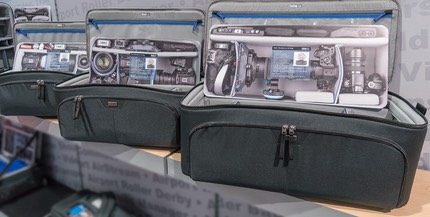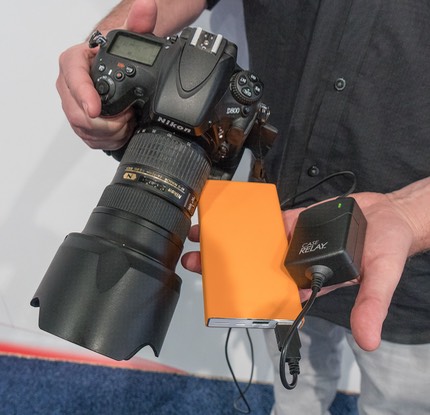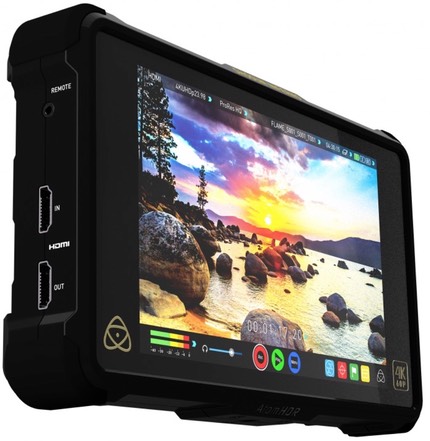Eek!
When I sat down to write this morning’s entries, my In Box had 150 new press releases in it. As I sit to write up the afternoon’s visits, you guessed it, another 100 press releases. This is a seriously big show, with a lot going on.
ThinkTank, whose bags I’ve used and recommended for years, came to the show with a rethink of their bag lineup targeted at video users. I’m just going to say up front, I like the new video bags—even for still work—though with a small caveat: the way the outer walls are constructed, you’ll lose just a bit of interior space compared to the similar still rollers.
The new video line consists of three sets: Workhorse, Transport, and Rig.

The Workhorse bags (above) are a set of three shoulder bags, but set up for carrying a small, medium, or large video rig that can be accessed quickly. Plus accessories, of course. These are designed to be working bags: protect the gear as you’re moving about, but have it fully accessible out of the bag quickly for shooting. The large one (25) seems a little big for me, but the two smaller ones (19 and 21) are a better solution than I’ve been using for my small ENG-type video rig. Oh, right, ENG: electronic news gathering.
Acronyms. I’ll try to explain them all, forgive me if I forget a few. It seems that every conversation I have at NAB is mostly just acronyms back and forth, with a few verbs.

The Transport bags are like the ThinkTank rollers I’ve been using. There’s an International carry-on sized one (18) and a domestic sized one (20). These bags have reinforced outer shells (including the flap you usually unzip to reveal the interior). There’s a light metal frame near the top and bottom, too. These Video Transports hold their shape better than the ThinkTank rollers I’ve been using, and have more protection against bumps.
But the thing I like about all these bags is that they hinge on the long axis (plus they have a holder that can keep the lids upright, rather than flopping over onto the ground behind. ThinkTank has changed their interior dividers, too, adding “pillows” and using both thin and thicker partitions. All the other usual ThinkTank touches pervade, including an outer zip compartment that can hold up to a 17” laptop. ThinkTank says “video body, four to six lenses, shotgun mic, small monitor, 4K recorder, plus accessories” would be a typical load.
Finally, there’s the Video Rig 18 and 24, which are big wheeled tubs—yeah they won’t like that I called them tubs, but they’re big and deep—which are designed to hold and protect a fully loaded video rig without dismantling it.
I also met with the Tether Tools folk, who were showing off their recently introduced Case Relay. This is a clever little accessory to extend power. For me, it’s most obvious use is shooting long overnight time lapses, but the Case Relay will find its place in the studio with tethered shooting and with DSLRs rigged for video.

The Case Relay itself is a small box (black box in palm above) with a 1200mAh battery inside. It’s designed to operate with the in-camera DC couplers, such as Nikon’s EP-5, though Tether Tools can also supply the appropriate coupler for any Nikon DSLR (and many other cameras). You put the coupler in where the battery is, plug it into the Case Relay and…here’s the nice part…plug the Case Relay into pretty much any external battery pack that outputs 2.1v on a USB port, such as the orange one shown above. If you run your external battery pack out, the internal battery in the Case Relay will keep you shooting while you swap out the battery pack. Clever and useful.
Here’s a closer look at one of the couplers that go into the battery compartment:

Versions for Nikon, Canon, Panasonic, and Sony cameras are currently available.

As I’ve written before, Nikon doesn’t have a booth at NAB this year. In fact, they’re downright invisible. I sort of expected that I’d see some Nikon guys and a presence at the Atomos booth, but no, at the humungous climbing wall with live climbers (!) there were a couple dozen cameras, with two lonely Nikon DSLRs at the end. More on Nikon’s invisibility in a moment, but first, Atomos.

The big news from Atomos was that they’ve updated their 4K recorders to HDR capability (for free). They also introduced an in-your-face bright Shogun Inferno model (1500 nits) that runs US$1995. Beside providing 4K 60P and 1080P/240 capability, that 7” monitor on it is so bright I doubt you’ll need a hood for it in bright sunlight. You might need a hood for it shooting indoors in dim environments, because it’s bright enough to use a modeling light.
Update: Atomos was a bit coy in their wording, and it didn’t take long for everyone to figure it out. While the full line of their recorders are indeed getting updates, really only the Ninja Flame and Shogun Flame have displays that are capable of rendering HDR correctly. The other recorders will handle the HDR data, but they display it with a profile that sacrifices color and contrast.
Okay, back to Nikon. Their invisibility here—at least so far in the two halls I’ve been through—is a mistake if they think they really want to play in the video game in the future. I can’t count all the mistakes Nikon is making on the video side, even though they’ve been getting a few things right (uncompressed HDMI output, support for the Atomos protocols, etc.).
I see a ton of Sony mirrorless cameras wandering around the halls. I see a number of Canon DSLRs in use. I haven’t seen a Nikon DSLR yet being used by anyone (I’m shooting with a Sony, mainly because I’m trying to finish reviews of two Sony cameras and a number of lenses for sansmirror.com). In booths, I see everything from A6300s and GH4s to Canon DSLRs to Canon C models to Blackmagic Design cameras all the way up to RED, and fairly ubiquitously around the hall.
But here’s the worse thing for Nikon: I see competitors for the not-yet-fully-announced Nikon KeyMission 360 in a higher quantity than I would have thought.
All of these cameras and competitors are getting plenty of visibility to the videographer customer, both to the 100k+ here at the show, but also to all the folk reading about the new products on the Web through dedicated video sites. Nikon is getting none that I can see. So Nikon trying to do anything other than “just include video with the DSLRs” would need to be dramatic to make an impact on the market now. The window is closed. Not closing. Closed. The fact that we haven’t gotten new primes that are video friendly seems to now be a foreshadowing: Nikon doesn’t get video.
Meanwhile, the Canon C lineup is fleshing out nicely. The Sony A series are mighty little still/video competitors. Blackmagic came in and created a whole line of video cameras that are becoming go to products for the lower budget crowd. And Nikon is nowhere to be seen.
A lot more happened today than I’ve reported. I spent an hour interviewing the CEO of a data recovery firm, but I’m going to save that for a future article, as he had a lot to say you need to hear, both on the still and video side. So there will be some trickle of other stories, news, and more for quite a while after the doors of NAB close.
Miles walked: 4.59 at the convention center alone





